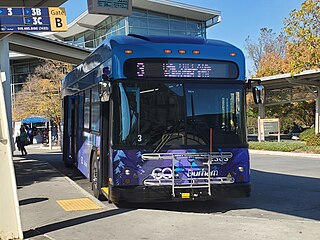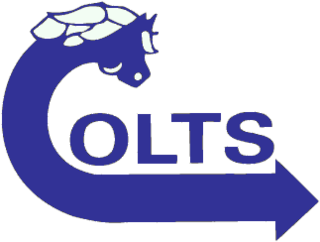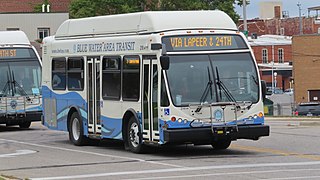
Eureka is a city and the county seat of Humboldt County, located on the North Coast of California. The city is located on U.S. Route 101 on the shores of Humboldt Bay, 270 miles (435 km) north of San Francisco and 100 miles (161 km) south of the Oregon border. At the 2020 census, the population of the city was 26,512. As of the 2010 census, the population of Greater Eureka was 45,034.

Rapid Ride was an express bus service with limited bus rapid transit (BRT) features which was operated by ABQ RIDE, the local transit agency in Albuquerque, New Mexico, from 2004 to 2020. The Rapid Ride name was phased out in 2020 with the rebranding of the one remaining Rapid Ride line as ARTx, though the service remains essentially the same.

The Interurban Transit Partnership, branded as The Rapid, is the public transit operator serving Grand Rapids, Michigan and its suburbs. In 2022, the system had a ridership of 5,106,600, or about 19,800 per weekday.

GoDurham, formerly Durham Area Transit Authority (DATA), is the public transit system serving Durham, North Carolina. It is currently operated by First Transit, managed by GoTriangle, and funded by the City of Durham. It was renamed under the consolidated GoTransit branding scheme for the Research Triangle region. In 2022, the system had a ridership of 5,304,400, or about 15,200 per weekday as of the third quarter of 2023.

The Sangamon Mass Transit District (SMTD) is a regional mass transit district that mostly serves Springfield, Illinois along with a few neighboring communities. It is governed by a seven-member board of trustees, who are all appointed by the Sangamon County Board of Supervisors. In 2022, the system had a ridership of 1,124,800, or about 5,000 per weekday as of the third quarter of 2023.
The Orbit fixed-route bus system began in 1990 in response to the growing population and congestion of the city of Huntsville, Alabama. The system is run by the city of Huntsville, and is funded by city and federal funds.

The Jule, formerly known as KeyLine Transit, is the operator of mass transit within the City of Dubuque, Iowa. The Jule offers transit bus routes throughout the city, trolley-replica transportation in Downtown Dubuque and the Port of Dubuque, and on-demand paratransit "MiniBus" service citywide. As of the 2011 rebranding, the transit system and city are now both named after Julien Dubuque. In FY 2010, the Jule recorded 371,000 rides.

The Redwood Transit System is a commuter transit service that operates Monday-Saturday on the Highway 101 corridor between Trinidad and Garberville in Humboldt County, California, and also serves Westhaven, McKinleyville, Arcata, Eureka, Fields Landing, Loleta, Fortuna, and Scotia. The RTS Willow Creek Extension operates between Arcata and Willow Creek during weekday commute hours.

Santa Rosa CityBus is a public transportation agency providing bus service in the northern California city of Santa Rosa. It provides service for over 2.8 million passenger trips annually.
Railway City Transit includes both conventional city transit buses and paratransit vehicles owned by the City of St. Thomas, Ontario and staffed and operated by Voyageur Transportation, who took over the service from Aboutown Transportation on January 1, 2012.

Metro Transit, previously known as Metro Area Transit, is Omaha, Nebraska's local mass transportation provider. Metro currently operates around 135 buses throughout the Omaha–Council Bluffs metropolitan area, including Bellevue, Ralston, La Vista, and Papillion in Nebraska and Council Bluffs in Iowa. Operated by the Omaha Transit Authority, a governmental subdivision of the State of Nebraska, Metro's board consists of a five-member board appointed by the mayor and confirmed by the Omaha City Council and the Douglas County Commissioners. The agency receives funds from local, state, and federal sources. The city has equipped its buses with bicycle carriers and onboard Wifi. The service hours of the entire system are generally from about 4:30 am–1:00 am on weekdays, 5:00 am-midnight on Saturdays, and 6:00 am–9:30 pm on Sundays, with many routes operating a shorter span.

Gainesville Regional Transit System is the local area transit corporation that serves the Gainesville, Alachua County, Florida area, the University of Florida and Santa Fe College campuses. It presently serves 40 city routes, 10 campus routes, and five "Later Gator" routes. Paratransit (ADA) service is also provided to anyone with a Gainesville address.

The County of Lackawanna Transit System (COLTS) is the operator of public transport for the city of Scranton urban area and its surrounding area of Lackawanna County, Pennsylvania. It began operations in 1972, largely using routes established by predecessor Scranton Transit. In 2022, the system had a ridership of 733,800, or about 2,900 per weekday as of the third quarter of 2023.
The Westmoreland County Transit Authority (WCTA) is the operator of mass transportation in Westmoreland County, Pennsylvania. Using 35 buses, a total of 18 routes are operated, the majority of which serve the urbanized corridor that makes up the western portion of the county. Bus routes in this area are designed to provide access for suburban commuters to Downtown Pittsburgh, as well as transportation for both workers and shoppers to the large suburbs of Greensburg and New Kensington, Pennsylvania the most prominent entities in the county's boundaries. Rural eastern bus routes allow for commutes to Greensburg and also provide service to the city of Johnstown in neighboring Cambria County.

The Beaver County Transportation Authority (BCTA) is the operator of mass transportation in Beaver County, Pennsylvania. Seven routes are provided, all of which serve the southern and central portions of the county, which are incorporated into suburban Pittsburgh. In 2022, the system had a ridership of 424,600, or about 3,500 per weekday as of the third quarter of 2023.

Lextran is a public transportation bus system serving Lexington, Kentucky. Lextran operates 25 bus routes throughout the city of Lexington. Buses converge at the Downtown Transit Center located at 220 East Vine Street. In 2022, the system had a ridership of 3,264,100, or about 13,300 per weekday as of the third quarter of 2023.

Mountain Metropolitan Transit is the public transportation operator for the metro area of Colorado Springs, Colorado, providing service to downtown Colorado Springs and surrounding areas within city limits and to the city of Manitou Springs, Widefield and Security. It has 27 local routes. In 2022, the system had a ridership of 2,315,800, or about 12,100 per weekday as of the third quarter of 2023.

Blue Water Area Transit (BWAT) is the public transit operator serving Port Huron, Michigan and surrounding St. Clair County. Operated by the Blue Water Area Transportation Commission (BWATC), the BWAT system includes fixed-route buses in the Port Huron area, plus commuter routes and paratransit services. In 2022, the system had a ridership of 865,300, or about 4,200 per weekday.

Macatawa Area Express (MAX) is the public transit operator serving Holland, Michigan, providing the area with fixed-route buses and paratransit services. Founded in 2000, the system takes its name from the Macatawa River and Lake Macatawa.
Manatee County Area Transit (MCAT) provides public transportation for Manatee County, Florida and is operated by the county. the system had about 4,100 riders per weekday as of the third quarter of 2023.





















